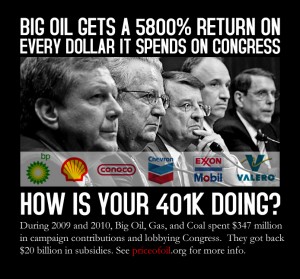 You can SHARE this infographic on Facebook.
You can SHARE this infographic on Facebook.
What if you were in Vegas, and a friend told you there was a slot machine in the corner that was giving out $59 for every $1 that was put in? You’d think the machine was broken, and that it was rigged.
What if an investment advisor told you that he could get you $59 back for every $1 you gave him? That’s a 5800% rate of return. Even Bernie Madoff only promised 10.5%. Obviously a scam, right?
Clearly this is a scam, but if you’re the oil, gas and coal industry, it’s legal and business as usual in Washington. For every $1 the industry spends on campaign contributions and lobbying in DC, it gets back $59 in subsidies.
Here’s how it works:
Amount the fossil fuel industry spent during the 111th Congress (2009 & 2010) on contributions to Congress’ campaigns: $25,794,747
Oil and Gas lobbying total 2009: $175,454,820
Oil and Gas lobbying total 2010 : $146,032,543
TOTAL amount spent by Big Fossil in 111th Congress: $347,282,110
2009 amount given to fossils in federal subsidies: $8,910,440,000
2010 amount given to fossils in federal subsidies: $11,578,900,000
TOTAL amount given to fossils during 111th Congress: $20,489,340,000
(Original OECD source for subsidies here and broken out by US Federal totals here)
Divide total subsidies by total money spent by the industry and you get 59.
$1 in. $59 out. That’s a 5800% return on political investment. Not bad.
(Note that an earlier post touched on this topic of return on political investment but did not include the lobbying figures and included conservative estimates of subsidies).

Damn…..
A couple thoughts regarding your methodologies: 1) you’ve included federal subsidies for coal but have not included them in your campaign contributions and lobbying totals, this skews your numbers by 1.56B in 2009 and 4.88B in 2010. 2) you’ve included “low-income home energy assistance program” in your list of federal subsidies. While this program does pay enegry cost for low-income persons, it is no more a subsidy for the gas & oil industry than Medicaid is a subsidy for the medical industry and SNAP/WIC is a subsidy for the food industry. Including these totals skew your numbers by $3.45B in both 2009 and 2010.
Josh – great questions thanks for paying attention to the details. In response:
-We have included campaign contributions from coal, that’s in our dirtyenergymoney database. We specifically developed that site to include coal mining and utilities that are at least 50% dependent on coal as coal money.
-You’re correct that we did not include lobbying expenditures from coal. That’s because the Center for Responsive Politics doesn’t break out coal lobbying and we don’t think all utilities or all mining is a fair proxy. In the future we would like to use the same dataset we use to get the campaign contribs from coal to get lobby numbers, but that’s a longer term task.
-I agree and disagree with you on LIHEAP. It is a subsidy that encourages something that is socially/environmentally undesirable (fossil fuel use – which is not like medical care) – but it is not something we would support eliminating – at least for some time to come. Because it obviously has another important social purpose, which is keeping people warm. Finally, we took that dataset on US subsidies from OECD, and by presenting it without editorial change, we’re just telling you what OECD says are subsidies.
-If we had made changes to the subsidy numbers they would be much higher and would include things like the U.S, Export-Import Bank, the Overseas Private Investment Corporation and the U.S share of support to multilateral development bank fossil fuel projects. Or military expenditures. Or health impacts.
For more info see here:
https://priceofoil.org/fossil-fuel-subsidies/
Thanks again.
The argument that medicaid is a subsidy to to the medical industry is actually quite reasonable IMO. The current “healthcare” paradigm is probably just as broken, crooked and socially harmful as the current energy paradigm. A different conversation yes, but worth considering.
Whether or not we consider that Medicaid might be considered a subsidy, I’m saying that medical care for those who can’t afford it is the kind of activity that I personally don’t see a problem with supporting with my tax dollars. I also don’t see a problem with helping the poor to heat their homes – I’d just rather see that support go to make better heating choices than oil.
Medicaid is a huge subsidy machine for big pharma. A friend of mine delivers psychotropic prescription drugs for a small pharmacy his wife has a ten percent interest in (this nets her $150,000 a year). Thanks to Medicaid, the “patients” only have to pay $1.10 per prescription. Guess who makes up the price difference?
An Alternative to Capitalism (if the people knew about it, they would demand it)
Several decades ago, Margaret Thatcher claimed: “There is no alternative”.
She was referring to capitalism. Today, this negative attitude still persists.
I would like to offer an alternative to capitalism for the American people to consider.
Please click on the following link. It will take you to an essay titled: “Home of the Brave?”
which was published by the Athenaeum Library of Philosophy:
http://evans-experientialism.freewebspace.com/steinsvold.htm
John Steinsvold
“Insanity is doing the same thing over and over and expecting a different result.”
~ Albert Einstein
Einstein’s definition of insanity is one way to look at it. Another is; deciding or doing what is not in your actual best interests.
Focusing on actual dollar amounts is ego’s favored game. Specifics mean nothing when the system is devoted against the public welfare. That it cannot, or will not recognize it is not relavant except to keep it ongoing.